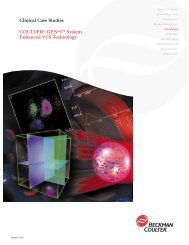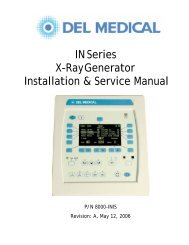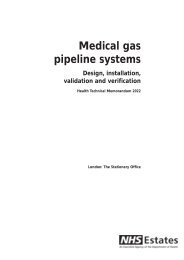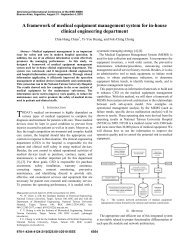Electrosurgery Self-Study Guide
Electrosurgery Self-Study Guide
Electrosurgery Self-Study Guide
You also want an ePaper? Increase the reach of your titles
YUMPU automatically turns print PDFs into web optimized ePapers that Google loves.
<strong>Electrosurgery</strong> <strong>Self</strong>-<strong>Study</strong> <strong>Guide</strong><br />
Electrosurgical<br />
Technologies<br />
As the sophistication of surgical procedures has evolved<br />
over time, so too have electrosurgical technologies.<br />
Meeting the challenge of improved patient care is but one<br />
of the goals of the medical manufacturing partner within<br />
the health care arena. The surgeon and perioperative<br />
nurse must be familiar with both long-standing<br />
technologies and with emerging ones so that the safest<br />
and most effective care is available to patients.<br />
Ground-Referenced Generators<br />
The first generation of electrosurgery units that were<br />
developed in the early 1900’s were ground-referenced.<br />
When using these units, it is earth ground that completes<br />
the electrosurgical circuit. These units were spark-gap<br />
systems with high output and high performance<br />
(Hutchisson, 1998), making them popular with surgeons.<br />
The major hazard when using a grounded system is that<br />
current division can occur. If the electrical current finds<br />
an easier (lower resistance) and quicker way to return to<br />
ground, and if the current were sufficiently concentrated,<br />
the patient could be burned at any point where the current<br />
exits the patient’s body (Figure 13).<br />
Figure 13 – Current Division<br />
This could be where the patient’s hand touches the side of<br />
the OR bed, a knee touches a stirrup, or any number of<br />
alternate exit sites (Figure 14).<br />
10<br />
Figure 14 – Alternate Site Burn<br />
In early models of ground-referenced generators, the<br />
surgeon could use electrosurgery regardless of whether a<br />
patient return electrode was attached to the patient. This<br />
resulted in patient burns. Later models offered a cord fault<br />
alarm, which alerted the staff if the patient return<br />
electrode was not plugged into the generator. The<br />
disadvantage was that electrosurgery could still be used<br />
even if the patient return electrode was not on the<br />
patient. Burns could also occur at the return electrode site.<br />
In 1995 the Emergency Care Research Institute (ECRI)<br />
stated that “spark-gap units are outdated and have been<br />
largely superseded by modern technology”. The Institute<br />
recommended that hospitals with surgeons who still insist<br />
on using ground-referenced units should obtain signed<br />
statements from these surgeons acknowledging the risk<br />
of using spark-gap electrosurgical units (Kirshenbaum,<br />
1996).<br />
Solid-State Generators<br />
Solid-state generators were introduced in 1968. These<br />
units were much smaller and used “isolated” circuitry. In<br />
isolated units, the electrical current produced by the<br />
generator is referenced to the generator and will ignore all<br />
grounded objects that may touch the patient except the<br />
return electrode. With isolated generators current<br />
division cannot occur and there is no possibility of<br />
alternate site burns (Figure 15).










